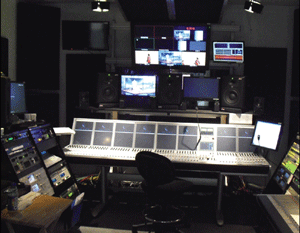Olympics Audio: A New Way for 5.1, Stereo
LONDON—Experience demonstrates that when mixing 5.1 audio practice makes perfect, and in London the third time was the charm. The experience gained by NBC’s crew mixing Beijing and Vancouver in 5.1—coupled with increasing work in 5.1 between Olympics— was a big factor in helping produce “the best sound we’ve had yet,” said Bob Dixon, director, Sound Design for IBC, venues and communications.

NBC Olympics Audio Room “This is a very pleasant show to listen to,” he said. “I don’t care what venue you tune in on; by and large it’s really comfortable and it’s fun. I think we’ve come a long way.”
Dixon was quick to credit host broadcaster OBS as a partner in developing mic plans and more. “They’ve been very handy to work with, and this year we’ve gotten all of our stems and mic splits from them as MADI signals, which made the work so much easier for them, and for us.”
SIMPLER MODEL
The big audio news from London was a change in the way NBC handled audio tracks. In recent Games where 5.1 audio was a factor, the network moved 16 tracks of audio around. In London a simpler 8-track model eliminated the Stereo workflows that were used in the past, and used either 6 channels for full Surround or a subset of just the first 3 channels. This 3 channel mode contains just the original Front L&R from the surround signal (used as Stereo EFX) and the mono announce channel on track 3.
This “split track” signal is far easier to upmix to Surround and sounds better than upmixing from a full 2 channel stereo mix, according to the NBC Olympics IBC tech manual and the network’s experience in London and at pre-Games test events.
Central to the new workflow were Linear Acoustic upmixers with special software for automatic detection of 3-channel or 6-channel content. The boxes would seamlessly change between upmix or bypass mode to make a consistent 6-channel output.
“We discovered by accident how much better an upmix sounds when you don’t include the announcer in that mix,” said Dixon. “The sound image we got out of mixing all these sound effects was stable; didn’t collapse to mono. It stayed full and open.”
The professional video industry's #1 source for news, trends and product and tech information. Sign up below.
Dixon said that if editors—who have a variety of audio comfort levels and are often working in rooms not ideal for 5.1— were uncomfortable working in 5.1, they could work in 3.0. In these situations, the editor would have access to a Miranda iSolo, which, when an HD/SDI signal is put into it, allows the user to do a downmix. It will put the center in the center automatically, and left goes to the left, the right goes to right, and the center goes to both.
“It comes out of there as a stereo mix,” he said. “We give them two speakers [the editors] and they will edit just as they always have in stereo. The thing is that they’re cutting across three channels, instead of two. So the announcer’s always separate.
“There are still some editors that want to work in 3.0, and that’s fine,” said Dixon. “And now that we have Tim’s box [Linear Acoustic President Tim Carroll, on-site in London], we don’t even have to worry about, ‘is this coming to us as a 3.0 or a 5.1?’ because it doesn’t matter—the box will pass it through if it’s 5.1 or will upmix in stereo effects only and pass the announcers if it’s 3.0.”
Dixon was very happy with the sound of the London Games, and on a personal note said that he was retiring after London. His Olympic career started in Los Angeles in 1984, and includes 12 Games in all.
